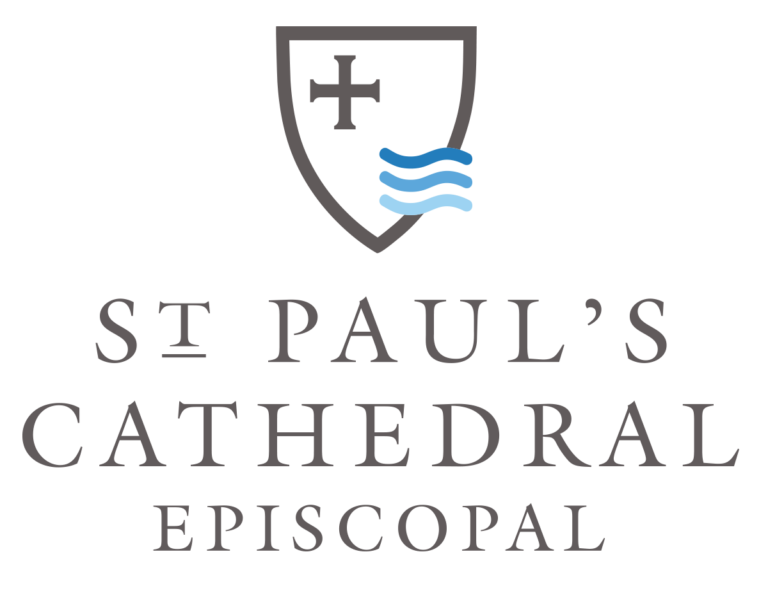Hello St. Paul’s,
Recently I polled a group of parishioners for questions they would like to ask about our traditions, and they came up with a whole list. If one person is wondering, it’s guaranteed that lots of other people are too, so here are some FAQs. You might notice that in many cases, a custom began out of practical necessity and a theological rationale or symbolism was added later. Note that customs vary enormously from one Episcopal congregation to another, and you may find few or even none of these in another Episcopal Church.
Why do we have a Communion rail?
The Communion rail or altar rail is a boundary that marks off the most sacred portion of the church, the sanctuary and altar. Its practical applications are 1) to prevent unauthorized persons and animals from wandering into the sacred precinct and possibly treating it with disrespect; and 2) to provide a support for people as they kneel to receive Communion. Some Communio rails, including ours, are almost entirely symbolic in their minimalist design.
What are Vergers?
A verger is a lay person who assists the clergy in the conduct of public worship, especially in the marshaling of processions. Vergers may be full-time or part-time, paid or volunteer. They carry a staff known as a virge (sic), from the Latin for “rod”. Verger ministry dates back to the middle ages when the verger would lead a religious or civic procession and with his virge in hand would literally clear the way if necessary. Our vergers are experienced altar servers so can oversee the acolytes’ activities as well as guiding clergy.
Why do we use Incense?
Incense is the resin of a plant that when added to burning coals produces a perfumed smoke. Incense is mentioned in the Psalms as a visual aid in imagining our prayers rising to heaven. It also serves to disguise other, less pleasant odors in the church. The smoke from a thurible (the vessel in which we burn incense) adds an air of mystery to our worship. St. Paul’s uses several varieties of incense, each with its own aroma, for different occasions. The person carrying the thurible is called the thurifer.
Why do we have Holy water stoups?
Many people find that crossing themselves with water that has been blessed by a priest, reminding them of their baptism, can be a helpful way to enter into a prayerful state of mind; hence the custom in many churches of providing holy water in small containers or stoups by the doors. Since the beginning of the COVID pandemic we have fasted from this custom in the interest of hygiene.
Why do we sprinkle dirt on coffins and urns?
As a casket is placed in the grave it’s traditional for loved ones of the deceased to deposit the first shovelful of dirt on top, signifying the finality of burial. In many places this custom has been delegated to the clergy who sprinkle a handful of dirt or sand on the container as we say “Earth to earth, ashes to ashes, dust to dust”, reminding all present that we came from the earth (Adam’s name means “creature of earth”) and we return to the earth.
Why do we have flowers in Church?
Flower arrangements are often the least expensive and simplest way to beautify a space. They can add to the festive air of a celebration, and they can, like incense, disguise unpleasant odors. Flowers symbolize the beauty of the life of faith and remind us that life in this world is fleeting.
Why do we dress the altar?
The altar is a table that has been consecrated for use in the Eucharist. It is traditionally covered with a white cloth, known as a fair linen, symbolizing a shroud. The altar may be dressed in a frontal, which is a cloth that covers the side of the altar facing the congregation. This adds festivity and may be changed to match the liturgical seasons. A Laudian frontal is a much larger cloth or carpet that completely covers the altar and reaches the floor on all sides. St. Paul’s has a number of different frontals, and we may remove the frontal for the penitential season of Lent.
Why do we use Candles in the liturgy?
Before the advent of electric light, candles served as the only means by which the clergy and choir could see to read the liturgical texts. They have remained in use for symbolic reasons: when the candles in the sanctuary are lit, it’s a sign that worship is about to begin and a prayerful atmosphere is appropriate. Candles flanking the Gospel book are a symbol of the light of Christ shining out in the world.
Why do we wear Vestments?
I have written about the various types of vestments and their symbolism elsewhere, but the answer to the basic question of “why vestments” is for uniformity at the altar: people of vastly different economic means and sartorial style are rendered equal when they all wear the alb or cassock over their street clothes. This reduces distractions and reminds us that we are all equal in the sight of God.
I’ll be away this weekend but I’ll see you at Homecoming on September 11.
Your sister in Christ,
Penny

